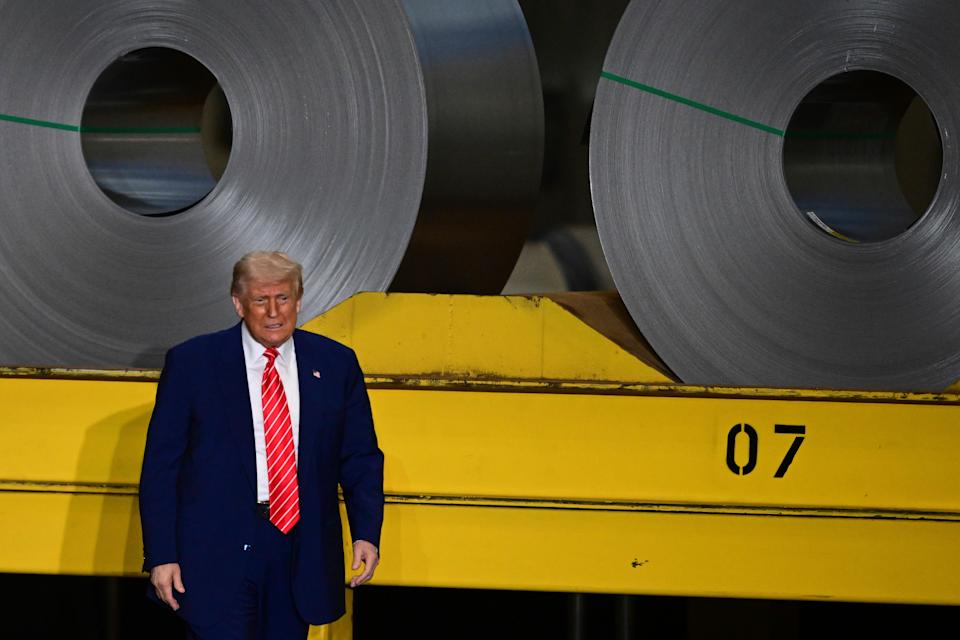
WafricNews – June 1st, 2025
WEST MIFFLIN, PENNSYLVANIA – Former U.S. President Donald Trump made what he called a “major announcement” on Friday, doubling down on protectionist trade policies by raising tariffs on imported steel from 25% to 50%. The announcement, made at a U.S. Steel plant before a cheering crowd of workers, marks a dramatic shift in American trade posture with potential ripple effects across global markets.
“We’re going to bring it from 25% to 50%, the tariffs on steel into the United States,” Trump declared. “Nobody’s getting over that fence.”
The move, effective June 4, was quickly confirmed via his Truth Social platform, where Trump said the higher tariffs would deliver another “BIG jolt of great news” for American workers and industry.
The Politics Behind the Protectionism
Framing himself as the savior of American steel, Trump claimed credit for reviving the struggling sector through his earlier tariffs in 2018. “Without my action, steelmaking in the U.S. would have disappeared,” he said, warning that foreign-made steel would have completely dominated the market.
While the tariffs may offer temporary relief to domestic producers, they risk triggering another wave of retaliation from major trade partners. In 2018, Trump’s initial steel tariffs were met with swift countermeasures from Canada, the EU, and others.
This time, the blowback was just as swift.
“We strongly regret the announced increase of US tariffs,” said Olof Gill, spokesperson for the European Commission’s trade office. He warned the decision “adds further uncertainty to the global economy” and said new EU countermeasures could take effect as early as July 14.
The UK government also signaled concern, stating it was working closely with Washington to protect British jobs and provide “clarity for industry.”
Economic Risk or Industrial Revival?
Trump invoked Section 232, a national security provision, to justify the tariff increase. But experts warn the move could raise costs for American manufacturers and construction firms, which depend on affordable steel. When the first wave of tariffs hit in 2018, a 2023 study by the International Trade Commission found that increased steel costs reduced economic output by more than $3 billion.
Spot prices for U.S.-sourced steel have already spiked since the original 25% tariffs were reinstated in March.
Last year, the U.S. imported $31.3 billion worth of steel and iron, with Canada being the largest supplier at $7.6 billion. The potential for trade wars or market disruptions looms large — especially as global economies remain fragile amid inflation and post-pandemic instability.
Trump Flip-Flops on Nippon Deal
In a surprising turn, Trump also reversed his stance on the controversial Nippon Steel takeover of U.S. Steel, a deal he once fiercely opposed alongside President Biden.
“I said there’s no way we’re gonna let that happen,” Trump told the crowd. “But every time they came in, the deal got better and better and better.”
Trump cited the inclusion of a so-called “golden share” — a special stake that gives the U.S. government oversight — as the key concession that convinced him to greenlight the sale.
He vowed to keep close watch: “I’m going to be in Washington. I’m gonna be watching over it.”
Steelworkers Celebrate, Markets Watch Cautiously
As Trump wrapped up his speech, he invited steelworkers to join him on stage — several of whom praised his efforts to protect their jobs and revive local industry.
“This is going to be one of the biggest days in your life,” Trump told them.
But while workers in West Mifflin may have reason to celebrate, Wall Street, foreign capitals, and U.S. manufacturers will be watching the fallout closely. Whether this bold tariff move strengthens U.S. industry or deepens economic divides — both at home and abroad — remains to be seen.
Stay with WafricNews for updates on U.S. trade policy, global economic impacts, and the politics reshaping industry in a multipolar world.
By WafricNews Desk.
By WafricNews Desk.


Comment
To post a comment, you have to login first
LoginNo Comments Yet...